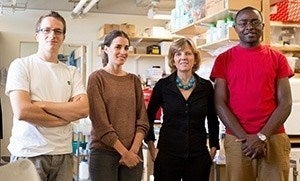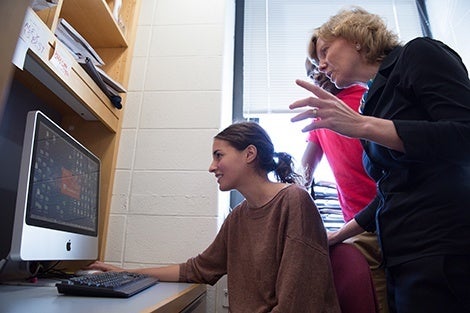The bacteria that cause tuberculosis are experts at survival, allowing the disease to persist even when faced with the immune system and drugs. Harvard T.H. Chan School of Public Health’s Sarah Fortune is on a mission to figure out why.
December 14, 2015 — Of all the health problems that dominate our thoughts and anxieties, tuberculosis (TB) probably ranks low on the list. But as infectious diseases go, it is a major global threat. Tuberculosis is among the top 15 causes of death worldwide, and it is estimated that a third of the world’s population is carrying the culprit bacterium, Mycobacterium tuberculosis (Mtb).
“Those global numbers reflect a lot of complexity, some of which is the co-epidemic with HIV/AIDS, which has just been catastrophic,” explains Sarah Fortune, Professor of Immunology and Infectious Diseases at the Harvard Chan School and a leader in TB research. “But that explanation is also too simplistic, and neglects the fact that TB just does not conform to our understanding of infection and cure in the way that many other infectious diseases do.”

Fortune heads up a group that is exploring the complexities of TB. In a bustling laboratory on the eighth floor of the Chan School’s Building 1, her team of 14 graduate students and postdoctoral fellows works across the spectrum of modern science. The group wields the latest imaging equipment to visualize microbes; employs advanced genomic methods, such as high-throughput DNA sequencing, to trace individual bacterial cells using their genetic material; and uses powerful informatics to wade through an ever-increasing amount of data.
A microbial black sheep
With most infectious diseases, there are two opposing outcomes: A person gets infected and eventually recovers, ridding the body of the pathogen and developing immunity to future infection. Or, the infection proves too challenging to overcome — with or without treatment — and the person succumbs.
Yet in TB, the relationship between microbe and man is much more complicated. People become infected and their immune system kicks into high gear. Yet these natural defenses, while designed for microbial annihilation, also inadvertently lead to the propagation of disease. Despite the body’s well-honed ability to kill millions and millions of bacteria, invariably a few are left standing — which means that those who are infected with Mtb remain infected.
“You have this giant pool of people who are carrying the organism and are at risk of developing active disease — getting sick — and transmitting it to others,” says Fortune. That pool significantly hinders efforts to control TB for two reasons. Currently, it is difficult to identify those who have latent disease. It is also difficult to predict which patients with latent disease will go on to develop an active infection, posing risks not only for individual patients but also for those around them who can contract the disease. In addition to these clinical challenges, there are equally significant challenges in the laboratory. “A lot of our fundamental understanding of TB comes out of studies of the 19th and early 20th century, and frankly, a lot of our assumptions about what the disease looks like are wrong. And we are only beginning to understand that now,” she acknowledges.
TB hits home
Fortune understands well the devastation that can be wrought by TB. As a medical student at Columbia University in the early 1990s, she found herself at the epicenter of a major outbreak of multi-drug resistant TB (MDR-TB) that spread across New York City and poured into the region’s hospitals — infecting and even killing several healthcare workers. The severity of that outbreak was on par with what is often now seen in parts of the developing world. “The reality of global TB was playing out right in front of our eyes, right in our own neighborhood,” she recalls.
 Within that crucible, Fortune’s future professional path was forged. Coinciding with the MDR-TB crisis in New York, the country was also grappling with the emergence and explosion of HIV, the virus that causes AIDS. As she pondered a direction for her research career, Fortune noticed a surge of interest in HIV, but relatively few laboratories dedicated to TB. “It struck me that more people needed to work on TB, so that was what I was going to do.”
Within that crucible, Fortune’s future professional path was forged. Coinciding with the MDR-TB crisis in New York, the country was also grappling with the emergence and explosion of HIV, the virus that causes AIDS. As she pondered a direction for her research career, Fortune noticed a surge of interest in HIV, but relatively few laboratories dedicated to TB. “It struck me that more people needed to work on TB, so that was what I was going to do.”
Now, some two decades later, her Chan School laboratory is harnessing state-of-the-art tools and uniting scientists from various disciplines to tackle TB. One of the keys to controlling the disease on a global scale, she believes, lies in understanding why Mtb is such a good survivor, both in the face of the immune response and in the face of drugs, which also fail to fully quash the bacteria. Her team focuses on these two facets of the disease by exploring a singular question: What is it about the Mtb population that allows a few cells to survive?
Bacteria as individuals
The prevailing idea is that, as a group, Mtb cells are not homogeneous. While most cells in a population are susceptible to killing by the immune system or by drugs, there are a few specialized “survivors” that constitute the group’s contingency plan — the “go to” cells when the going gets tough, as it does when the immune system flares or when drugs flow. Fortune believes that these rare, specialized cells are why TB treatments are so protracted — a 6-month course of antibiotics is needed to treat the disease — and also why it has been so difficult to develop an effective TB vaccine.
To strike at the heart of these problems, Fortune’s laboratory seeks to understand how the TB contingency cells form in the first place. Biologically speaking, there are a few possibilities. The cells could vary genetically, through changes to their DNA. They could also differ as a result of variations in their epigenome, a chemical code embedded within DNA that determines when and where certain genes get switched on or off. And finally, they could be programmed through molecular differences set in motion by a key group of regulators called transcription factors.
This notion of bacterial individuality signifies a stark departure from the picture of Mtb that was commonly held as recently as a decade ago. Imagine a caveman, Fortune says: “I’m going to hunker down, I’m not going to do very much, and that is how I am going to survive.” The idea made some sense at the time because Mtb is coated with an unusually tough outer shell made of wax — a kind of molecular bomb shelter that can protect against the threat of the immune system and drugs.
But Fortune and her team are learning that these presumed do-nothing microbes are in fact much more sophisticated than once thought, and that some of the bacteria adopt unique roles. Unlike most cohabitating bacteria, which each perform the same functions for individual gain, Mtb can adopt distinct roles in service of the entire group — making them more like a colony of bees than a colony of bacteria.
A lesson in geometry
Fortune’s team has made significant strides in the past few years in figuring out how Mtb variability arises, particularly as it relates to the response to drugs. This work not only has major clinical implications — understanding why some bacteria are susceptible to drugs and others are not could improve patient care — but it also relies on a time-tested approach in the laboratory: growing Mtb in the presence (or absence) of different drugs. While these studies may be conceptually straightforward, what they are revealing is striking. Fortune and her colleagues have discovered that differences in drug response stem from the way in which the bacteria reproduce.
Mtb is rod-shaped and looks rather like a miniature cucumber. Most bacteria of this shape grow simply by elongating — like a slinky that gets stretched from both ends and then snipped in the middle — to give rise to two, virtually identical “daughter” cells. But Mtb takes a different approach. The mother cell grows asymmetrically, by extruding one if its cucumber-like ends, and then divides at its center. That leaves one daughter cell with mostly new contents (corresponding to growing end) and the other with the lion’s share of the old stuff.
This dichotomy between old and new turns out to have important biological implications, resulting in physiological differences between what can get in and out of the cells, and how fast they grow — processes that are exquisitely sensitive to antibiotics. For example, the Mtb daughter that inherits the brand new cell wall is more susceptible to certain types of antibiotics than her hand-me-down clad sister.
“It’s a very simple geometric solution that creates a huge amount of variation in the individual cells in a population,” says Fortune. This elegant approach is not unique to TB — mammalian cells, particularly stem cells and cancer cells, also use asymmetric division to generate cellular diversity.
A solvable problem
Now, Fortune is moving on from studies of drug resistance to address the thorny question of how variability in Mtb growth enables the bacterium to survive the human immune response. Two critical elements are making this work possible: technology and collaboration.
To study bacterial individuality, researchers need to study individuals — that is, single cells. Thanks to advances in genomics and single-cell technologies, it is now feasible to mark each bacterium with a unique bar code and then follow the fate of each cell. Fortune and her colleagues are leveraging these capabilities to study Mtb infection in animal models. Such in vivo studies are incredibly complicated — “more complex by orders and orders of magnitude,” says Fortune — than their previous work.
Although these studies are challenging, the potential payoff is huge: The findings promise to open a window on the biological factors that allow a select few Mtb cells to dodge the immune system. During Mtb infection, the bacteria take up residence inside immune cells called macrophages, typically the first line of defense against microbial invaders. While most macrophages can kill their unwelcome guests, some cannot. The question is, why? Does the fault lie with the macrophage or with the bacterium? Or is it the bacterium-macrophage combination? With the ability to capture and analyze single cells, both bacterial and immune cells, Fortune is now exploring these very questions.
The outcomes will not only inform our biological understanding of TB, but could also propel the development of a vaccine — a holy grail of modern TB research. “All of the epidemiological models suggest that the way the global TB epidemic is going to be stopped is through an effective vaccine,” explains Fortune.
While there is a long-standing vaccine against TB, known as bacille Calmette-Guerin or BCG, its impact on disease spread is minimal. The most commonly administered vaccine worldwide, BCG mainly protects babies and young children from a form of TB that affects the central nervous system (known as TB meningitis) — but it is not effective against pulmonary TB, the transmissible form of the disease. Unfortunately, innovation in this area has not yet met with success. The results of a large clinical trial of a new TB vaccine, published in early 2013, proved deeply disappointing, showing no greater protection from TB than that offered by BCG. It was the first new candidate TB vaccine in 90 years.
Despite these and other challenges, Fortune remains undeterred — and optimistic. She acknowledges that the recent missteps in TB vaccine development only underscore how much we have yet to learn about TB and its culprit bacteria before a potent vaccine can be engineered.
While gaining that knowledge is a formidable challenge, it is not insurmountable. “We have the ability to conquer TB. It is a biologically solvable problem,” she says.
photos: Emily Cuccarese
